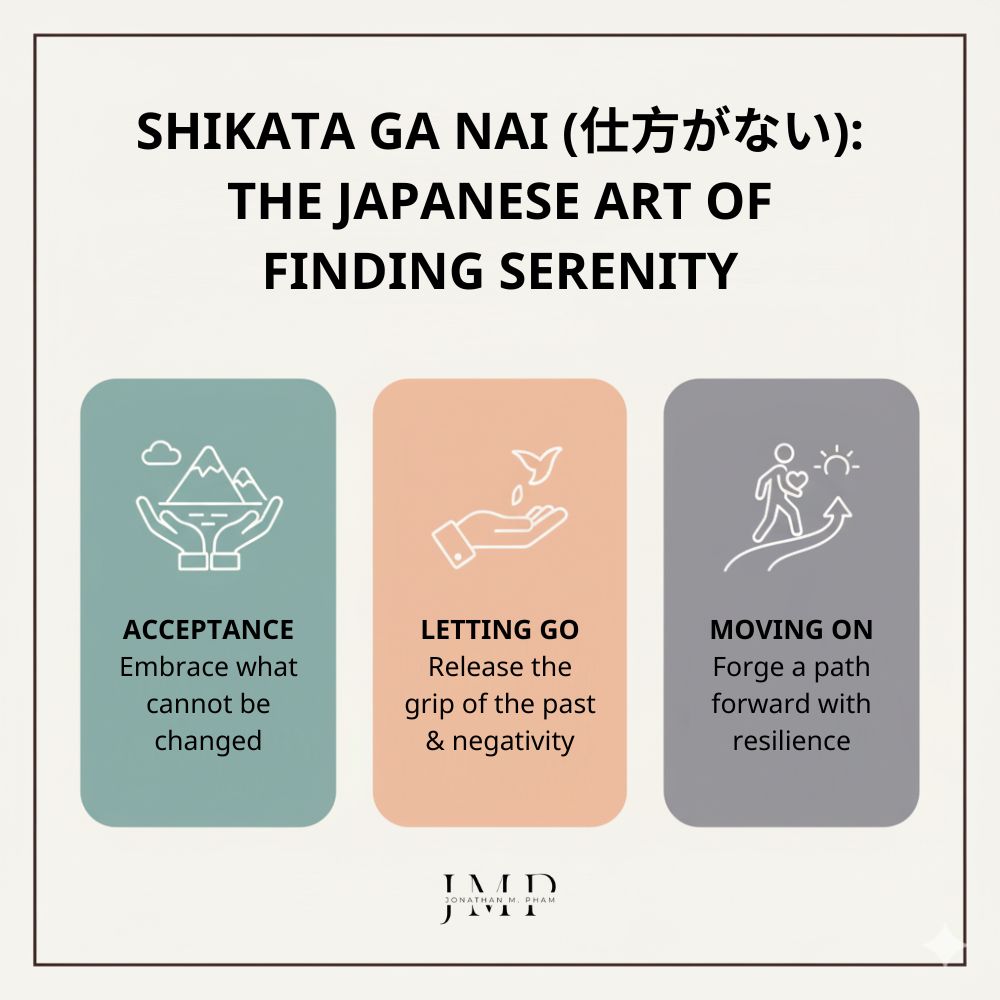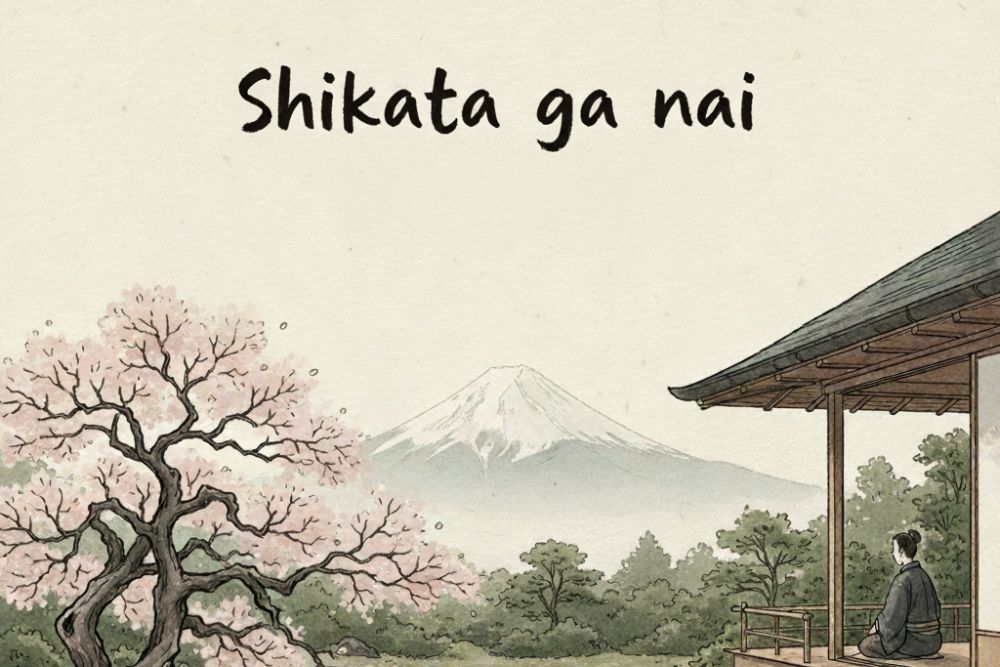Ever feel overwhelmed by life’s curveballs? Dive into the world of “Shikata ga nai,” the Japanese art of finding serenity in acceptance. Explore its meaning, its practical applications, and how it can transform your approach to life’s challenges!
Years ago, I started to develop a strong fascination with Japanese culture. Their stress on adopting a minimal and mindful lifestyle, the remarkable resilience of the Japanese spirit, and concepts like Ikigai (生き甲斐), wabi-sabi, etc. all resonated with me profoundly. As I delved deeper, I stumbled upon the phrase ‘Shikata ga nai’ – which intrigued me and prompted me to embark on a quest to understand its significance.
Highlights
- Shikata ga nai is a Japanese concept that teaches acceptance of what’s out of our control and moving forward with focus and resilience. It shares similarities with Stoicism (focusing on controllables and accepting uncontrollables) and Buddhism (acceptance through impermanence) – but differs in its emotional nuance and worldly focus.
- The term’s roots in Japanese history reflect an enduring acceptance of nature’s power and social hierarchy, as well as the tendency to prioritize group harmony and embrace personal inconveniences for the greater good.
- The philosophy of Shikata ga nai offers us a sanctuary to foster resilience, inner peace, and positivity; additionally, it also helps build stronger social bonds and navigate life’s challenges with greater ease.
- Shikata ga nai’s emphasis on acceptance may prove challenging for those valuing control, complaining, speed, or individual needs. To practice its principles, one needs to engage in activities such as mindfulness, journaling, minimalism, Stoic exercises, and accepting inconveniences with a focus on what they can control.
- Shikata ga nai’s power comes with potential downsides like inaction or ignoring injustice; however, these can be navigated through strategies such as discernment, healthy expression, and choosing battles.
What Does Shikata ga nai Mean?
Shikata ga nai (Kanji: 仕方がない, Hiragana: しかたがない) or Shouganai (しょうがない), literally meaning “it cannot be helped” or “there is nothing to be done,” is a Japanese concept that goes beyond a simple shrug of resignation. It’s a philosophy centered on acceptance and moving forward.
- Acceptance: We all know that despite our best efforts and intentions, there are always things in life that are outside our control (e.g. natural disasters, traffic, an unpleasant colleague, etc.). We can’t change the past or force situations to bend to our will. Instead of moaning, dwelling on what was, or burying our heads in the sand, Shikata ga nai encourages us to recognize (and embrace) our limitations and the inherent randomness of life.
- Letting go: Dwelling on what we can’t change is a recipe for unhappiness. As such, we need to release that grip, let go of negative emotions, and focus our energy where it can be productive.
- Moving on: By accepting things as what they are, we may find the inner resilience necessary to keep moving forward and forge a constructive path ahead. As we learn to keep our minds off what we can’t control, we free ourselves from the emotional turmoil it can cause and start treading the path toward true inner peace.

A common misconception about the philosophy is that it promotes inactivity and pretending things are okay when they’re not. Rather, its core message is about maintaining one’s sense of perspective and emotional control under all circumstances.
Shikata ga nai doesn’t mean being apathetic or ignoring reality. It’s about acknowledging the situation while focusing our efforts on what we CAN ACTUALLY influence (e.g. our actions, reactions, and perspectives) – so as to avoid feeling overwhelmed and powerless. In other words, we are encouraged to zoom out and observe the situation in a larger context – without getting bogged down in the emotions of the immediate moment. Challenges are inevitable, but they don’t have to define us.
While emotions are a natural part of human beings, Shikata ga nai discourages getting overly emotional about things beyond our control. Taking a more measured approach allows for clearer thinking and more effective problem-solving.
In essence, Shikata ga nai is a philosophy for navigating life’s inevitable ups and downs with grace, resilience, and a focus on what truly matters.

Shikata ga nai symbol – Paper cranes
Shikata ga nai vs Similar Philosophies
The concept of Shikata ga nai shares interesting parallels with other philosophies around the world – namely Stoicism and Buddhism.
- Stoicism
Like Shikata ga nai, Stoicism emphasizes focusing on what we can control (our thoughts and actions) and accepting what we can’t (fate, external events). Both philosophies encourage practitioners to detach from negative emotions caused by uncontrollable forces – and learn to live in the present.
That said, Stoicism might be seen as a more proactive approach – in that it places a greater emphasis on maintaining logic and reason in the face of adversity. On the other hand, Shikata ga nai promotes a more accepting and emotionally nuanced stance toward difficult situations. Specifically, we are to admit the emotional impact of challenges – while also letting go of those emotions, rather than necessarily suppressing them.
- Buddhism/ Zen
Buddhist philosophy, including Zen, shares the concept of acceptance with Shikata ga nai. Both aim at achieving inner peace through realizing the impermanence of life – and letting go of attachment to desires and expectations, a source of suffering.
The difference between them is that Shikata ga nai focuses on external uncontrollable events, while Buddhism stresses the importance of abandoning internal attachments as well. In addition, the latter has a more spiritual foundation compared to the former’s more secular and practical nature.
| Feature | Shikata ga nai | Stoicism | Buddhism/Zen |
| Focus | Accepting uncontrollable external events | Accepting what you can’t control (fate, external events) and focusing on what you can (thoughts, actions) | Accepting the impermanence of life and letting go of attachments (desires, expectations) |
| Goal | Inner peace through acceptance | Inner peace through reason and logic | Inner peace through detachment from suffering |
| Emotional response | Acknowledge emotional impact and let go | Suppress negative emotions | Abandon attachment to desires, which cause suffering |
| Emphasis | Acceptance and emotional nuance | Proactive, logical reasoning | Letting go of internal and external attachments |
| Nature | Secular and practical | Practical with philosophical underpinnings | Deeply spiritual |
How Japanese Practice Shikata ga nai
Japanese culture has always placed a strong emphasis on social harmony (wa – 和) and collectivism. People are often expected to prioritize the group over the individual. As such, Shikata ga nai becomes a way to accept situations that might cause personal inconvenience for the greater good. A train delay? Shikata ga nai. A noisy neighbor? Shikata ga nai (sometimes). It’s a way to acknowledge the situation and move on without letting it ruin the day or damage group cohesion.
The philosophy is strongly complemented by the Gaman (我慢) notion, which promotes a type of “Stoic endurance” – that one needs to persevere and bear hardship without complaint. Additionally, it is also interconnected with the Wabi-sabi (わび・さび – 侘寂) concept, which highlights the beauty that can be found in imperfection and impermanence, and Oubaitori (桜梅桃李), which emphasizes that we need to realize each individual’s uniqueness and stop making comparisons to others. Together, they create a cultural framework for navigating challenges without disrupting social harmony.
Aside from daily life, the mindset of Shikata ga nai is particularly relevant when it comes to natural disasters like earthquakes, which are a constant threat in Japan. The Tohoku Earthquake and Tsunami (2011) is a prime example. Despite Japan’s world-leading disaster preparedness, the sheer power of the disaster caused immense devastation. In the aftermath, the concept of Shikata ga nai played a significant role, as people acknowledged the immense natural forces at play and focused their energy on helping each other rebuild.
Again, it’s important to remind that Shikata ga nai doesn’t equal passive resignation. It’s a recognition of limitations – coupled with a proactive approach to choosing the most effective course within those confines.
Despite the universal emphasis on emotional control, Japanese culture has outlets for expressing emotions. Activities like karaoke or venting to close friends allow for emotional release alongside Shikata ga nai’s focus on acceptance.

History of the Shikata ga nai Philosophy
While the exact origin of Shikata ga nai (仕方がない) is unclear, its roots are deeply embedded in Japanese history and culture:
- Natural disasters: Japan is a land prone to earthquakes, tsunamis, and typhoons. These unpredictable events have likely played a significant role in shaping the Japanese worldview – accepting the uncontrollable forces of nature and focusing on rebuilding/ moving forward.
- Historical upheavals: For centuries, Japan was a feudal society with rigid social hierarchies – in which people were expected to accept their place in society. In addition, the country has continuously faced periods of hardship and social upheaval. From feudal warfare to the devastation of World War II, the concept of acceptance embedded in Shikata ga nai may have provided a way to cope with these collective struggles.
- Social harmony: As mentioned above, Japanese culture has always valued collectivism and social order, which requires individuals to often take a backseat to the well-being of the group. Shikata ga nai fostered a sense of acceptance when personal desires conflicted with the needs of the greater good.
Why is Shikata ga nai Important?
Spilt water will not return to the tray. (Fukusui bon ni kaerazu – 覆水盆に返らず)
- Resilience: Accepting what’s beyond our control is the precedent to bouncing back from setbacks more effectively. In doing so, we give ourselves the chance to avoid getting stuck in negativity and free up energy to find solutions or move on.
- Inner peace: Constantly struggling against the inevitable will only lead to stress and anxiety. Adopting the Shikata ga nai mindset promotes acceptance, which reduces emotional turmoil and fosters a sense of peace and well-being.
- Gratitude & positivity: Shifting the focus from what we lack to what we can control helps cultivate gratitude for the good things in life. This positive outlook plays a major role in enhancing one’s holistic well-being.
- Stronger social relationships: In a collectivist society like Japan, prioritizing the group is important. Shikata ga nai enables people to accept inconveniences for the greater good, thereby fostering stronger social bonds.
- Stress management: Studies have shown a connection between chronic stress and various health problems. Accepting what can’t be changed allows us to experience less anxiety, which translates to better physical/ mental health. In fact, according to an article published in The Japan Times, the Shikata ga nai perspective may contribute to lowering blood pressure – therefore resulting in a potentially longer lifespan.
The benefits of Shikata ga nai go beyond a simple checklist. It’s a way of life that teaches us to navigate the world with a realistic outlook. It doesn’t mean giving up; rather, by accepting what is and focusing our energy on what we can control, we become empowered to find solutions, maintain a positive attitude, and ultimately live a more fulfilling life.
Shikata ga nai isn’t just a resigned shrug. It’s a philosophy that combines realism with hope and acceptance. It reminds us that while life throws curveballs, we always have the power to choose our response.
Think about recent crises like the Covid-19 pandemic. What could be a better example of when the philosophy of Shikata ga nai became so relevant? The virus itself and its spread were largely out of our control. Lockdowns, travel restrictions, and business closures became necessary responses, even though they disrupted daily life. That is not to mention the possibility of getting sick – and even facing death at any time.
While the overall situation wasn’t controllable, individuals could still decide what to do – hygiene practices, social distancing, and following public health guidelines.

The Beauty of the Shikata ga nai Philosophy
Shikata ga nai’s philosophy offers a powerful tool for navigating the stress and constant change of the modern world. By acknowledging what’s beyond our control, we can focus our energy on what we can influence, leading to better stress management and a more balanced life. This acceptance also fosters resilience in the face of unexpected challenges, allowing us to adapt without discouragement.
Additionally, recognizing our limitations helps us prioritize effectively, avoiding wasted effort and directing our focus towards areas where we can make a real difference. As we navigate life’s inevitable challenges, we also learn about the importance of compassion and empathy – both for ourselves and others.
Despite its benefits, the concept is often misunderstood in Western cultures, which tend to value individual achievement and control over one’s destiny. As such, Shikata ga nai’s emphasis on acceptance is frequently misconstrued as passivity or resignation. In addition, the “get things done” attitude prevalent in the West may make Shikata ga nai seem like an excuse for inaction – while in reality, it’s about choosing our battles and focusing efforts where they can be most productive. In doing so, not only may one attain a sense of serenity, but they also free themselves from the risk of burnout and frustration due to the relentless pursuit of vanity goals.
Accept what is, not what should be.

Read more: Memento Mori – A Reminder of Life’s Impermanence & How to Live the Right Way
Challenges of Adopting the Shikata ga nai Perspective
Adopting the Shikata ga nai philosophy often proves challenging, especially for those coming from a very different cultural background. Here’s how some common traits may clash with the concept’s core principles:
- Arrogance & a sense of control: Shikata ga nai goes against the idea that we can control everything in our lives. As such, people who hold a strong belief in their own control or have a more arrogant view of their capabilities might find it difficult to accept the existence of things beyond their influence.
- Complaining culture: In some cultures, complaining is a common way to vent frustration or seek solutions. Shikata ga nai, however, encourages acceptance and moving forward, which may cause many to feel dismissive of legitimate concerns.
- Impatience & the “fast-paced” mentality: Modern life often prioritizes speed and efficiency. Shikata ga nai’s emphasis on acceptance and going with the flow might clash with a desire for instant results.
- Little care for harmony: Individualistic people might have difficulty resonating with the emphasis on social harmony. The tendency to prioritize personal needs over group peace (which translates to lower empathy) is what makes it harder to accept inconveniences for the sake of others.

Considerations When Practicing Shikata ga nai
Shikata ga nai, while a powerful philosophy, comes with its potential downsides. Here’s a breakdown of the challenges and how to navigate them effectively:
- Excuse for inaction: There’s a risk of people using it as a crutch to avoid taking action, especially when change is possible. It’s crucial to differentiate between genuine uncontrollable events and situations where effort can make a difference. Simply saying “Shikata ga nai” to everything will just lead to missed opportunities and deny the chance for personal growth.
- Silence in the face of injustice: The concept shouldn’t be used to justify ignoring injustice or wrongdoing. There are times when speaking up or taking action is necessary. Even though we still need to regulate our emotional response to injustice, it shouldn’t prevent us from working actively toward positive change.
Tips to overcome the above-mentioned issues:
- Discernment is key: The core principle is to distinguish between what can and cannot be controlled – and then focus your energy on areas where your actions can make a difference. Question yourself “Can I change this?” If the answer is yes, then Shikata ga nai doesn’t apply. Take action or advocate for change.
- Healthy expression of frustration: Acknowledge your feelings of frustration or anger before accepting the situation. Find healthy ways to express these emotions, like journaling or talking to a trusted friend/ coach/ mentor.
- Choose your battles: Not everything needs to be a fight. Discern when acceptance is the most productive course of action and when assertive action is essential. For example, let’s say you wake up late for work. Due to a sudden downpour that flooded the roads, public transportation is running slow. You’re stressed because you know your boss isn’t very understanding about tardiness. In this case, fretting about the rain or getting angry at the situation wouldn’t help. Shikata ga nai allows you to accept the uncontrollable element (rain) and focus your energy on what you can influence (communication and making up the time).
- Seek improvement when possible: Don’t confuse acceptance with resignation. If there’s a possibility for improvement, explore those avenues while maintaining a sense of peace about the potential outcome. Whatever you do, always take responsibility for your own choices and actions.
- Finding your voice: Shikata ga nai doesn’t mean silence. When you see something wrong, find a way to speak up that aligns with your values and personality. This could be direct communication, supporting a relevant cause, or even creative expression.
Here’s an analogy: Imagine life as a flowing river. Sometimes, you can paddle upstream and make progress. Other times, the current is too strong, and you need to go with the flow while strategically positioning yourself for when the current weakens. Shikata ga nai teaches us to discern these situations and respond accordingly.
Read more: Asking for Help – The Power That Comes From Vulnerability

How to Practice the Shikata ga nai Philosophy in Life
Cultivating the mindset
- Mindfulness meditation: Regularly practicing mindfulness helps you become aware of your thoughts and emotions without judgment. This allows you to observe frustration with a flat tire, for example, without getting swept away by negativity.
- Journaling: Focusing on what you’re grateful for fosters a positive outlook and enables you to appreciate the good things in life, even amidst challenges. On the other hand, writing about difficult situations is a great way to process your emotions and identify areas within your ability to impact.
- Living with less: A minimalist lifestyle – characterized by regular decluttering and reduced commitments – aids in reducing unnecessary attachments and simplifying your life, thereby making it easier to let go of things beyond your control.
- Stoicism exercises: While Shikata ga nai is not identical to Stoicism, exercises like visualizing worst-case scenarios may help you prepare for the unexpected and develop emotional resilience.
Applying in daily situations
- Flat tire: You get a flat tire on your way to work. Acknowledge the inconvenience and calmly assess the situation. Can you fix it yourself? Do you need to call for help? Focus on what you can control (calling roadside assistance, staying calm) and accept the delay (you might be late for work).
- Missed train: You rush to the station only to see your train pull away. In that case, acknowledge your frustration, take a deep breath, and check the schedule for the next train. Use the waiting time productively (catch up on reading, make a call).
- Bad weather: You planned a picnic but it’s raining all day. Accept the change in plans, and either consider alternative indoor activities (board games, movie night) or reschedule your picnic for a sunny day.
- Unexpected delays: A meeting runs long, causing you to miss other appointments. If that’s the case, just apologize for any inconvenience caused and reschedule where possible. Focus on what you can control – prioritizing tasks and remaining calm under pressure.

Additional tips
- Acceptance doesn’t mean happiness: It’s okay to feel frustrated or disappointed in challenging situations. Embracing your emotions is part of the process.
- Think solutions: Once you’ve accepted the situation, explore ways to navigate it effectively. At the same time, make sure to practice self-compassion and avoid harsh self-criticism when things don’t go according to plan.
- Use it as a mantra: When faced with a challenge, silently repeat “Shikata ga nai” to yourself as a reminder to accept the situation and focus on what you can do.
- Humor as a tool: Sometimes, a little humor should lighten the mood and allow you to approach the situation with more acceptance.
- Focus on the bigger picture: Ask yourself, “Will this matter a week from now?” For instance, a flat tire is just a bump in the road, not the end of your day. This perspective shift should enable you to prioritize and let go of minor inconveniences.
All in all, don’t expect to master Shikata ga nai overnight. It’s a philosophy that takes time and consistent practice to integrate into your life. Be patient with yourself and celebrate your progress along the way!
Read more: 12 Stoic Principles to Live by in the Modern Life
Final Thoughts
Since I first came across the term “Shikata ga nai,” it has become a constant companion in my mind. Many times, I find myself muttering it during frustrating commutes or unexpected setbacks. While adopting this philosophy fully has proven more challenging than I initially anticipated, it’s a journey I’m determined to continue – one that I believe will continue to enrich my life (and yours too) for years to come!
Other resources you might be interested in:
- Find the Beauty in Everyday: How to Uncover Joy & Wonder in the Little Things
- Grit & Resilience Quotes: Persevere Through Challenges
- 28 Motivational Success Stories in Real Life
- Self Discovery: An Expedition to the Core
- The Secret Life of Water (by Masaru Emoto) Book Review
Let’s Tread the Path Together, Shall We?


